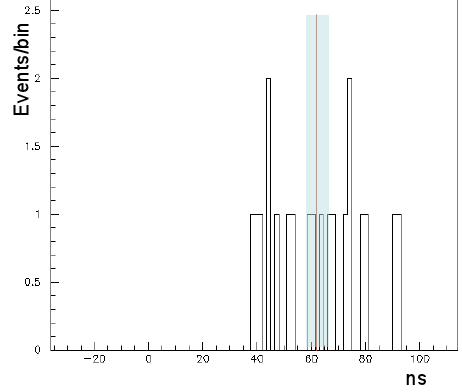Some more detail on the new experiment. Of particular interest is the follow up
based on a seminar they gave. The jitter: as you can see from the distribution I posted in the other article earlier today, showing the "delta t" for the 20 new neutrino interactions obtained from internal and external charged current interactions detected by Opera during the fast pulse runs of the CNGS beam, the jitter of 50 nanoseconds is causing the neutrino events to occur at random according to a uniform distribution, a "box" of width equal to 50 nanoseconds. What is causing this jitter had escaped me during the first careless and quick reading I gave to the paper last night. It is due to the fact that Opera cannot actually measure times with better than 50 nanosecond resolution: their "clock" runs at 20 megahertz, so they have a 50-ns "granularity" in the measurement.

That image is their actual data. You might notice that no bin has more than two counts in it. The original data set had far more measurements over a far larger time span. This was a shorter, tighter bunch with far fewer samples.
The jitter is quite worrying for me. Their synchronisation comes from a 20MHz clock, 50 nanosecond resolution. A single tick error is all you need to effectively erase the entire result. I'd expect this kind of thing to be a no-brainer and easily checked for, but all it takes is one variable in their various programs to use the wrong initialisation to get that sort of error.
Also, these new results did not eliminate all possible error sources. I'd expect confirmation to take another few years worth of full measurements, as well as independent measurements on different sites. I know there is a Fermilab collaboration working on this, which is one I'm certainly watching.
But putting that aside and assuming the result is real, there are a few points to consider for any new physics happening here.
The first point is that it's not just the 'speed limit' that suggests this couldn't happen.
There were a couple
early responses that rather convincingly made the case that you would expect a form of
Bremsstrahlung - radiation emitted by a moving particle. Usually you only see this due to accelerated charges, but they showed that a superluminal neutrino would also emit particle/anti-particle pairs. While this doesn't mean neutrinos can't travel faster than light it does put a limit on their energies when they do. Those energies are not compatible with these neutrinos making this particular flight at the (supposedly) detected speed.
One of the arguments I've found most convincing here is that the neutrinos are not travelling faster than light for the entire distance. Instead there is some initial super- or hyper-luminal jump in the initial creation/decay of the neutrons.
There is a discussion of this
here which is fairly interesting, if a little hard to follow in places. And the guy who wrote that certainly has a horse in the race, claiming this strongly supports his model of emergent gravity.
In a sense this is even more interesting as it suggests the superluminal action is taking place in the decay phases, involving pions and kaons. It's also somewhat testable. If there is a comprehensive confirmation of the basic result using this of equipment then it's likely that Fermilab can sort of test if the change comes from the early phase. The detectors being used to measure the Fermilab neutrinos use two neutrino detectors in sequence, measuring the flight time between the two. The CERN measurements are from creation of the neutrinos to their final and single detection. Seeing FTL in CERN and not Fermi would suggest the difference is in the creation/decay process.

 Author
Topic: CERN has accidentally the everything. (Read 65200 times)
Author
Topic: CERN has accidentally the everything. (Read 65200 times)
